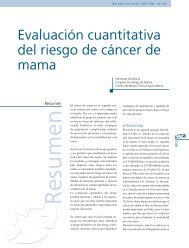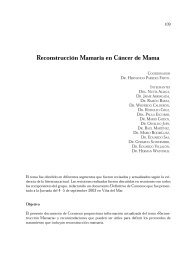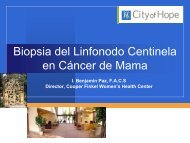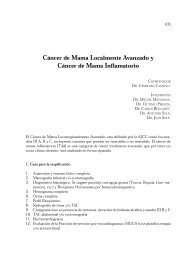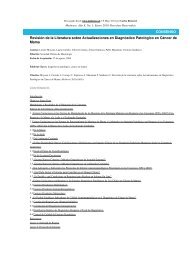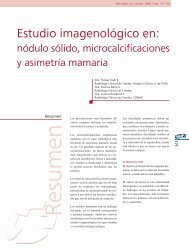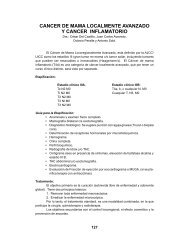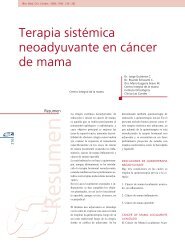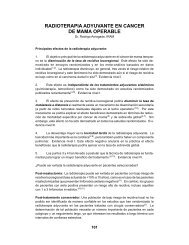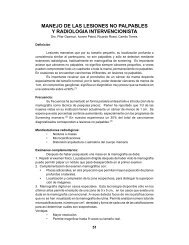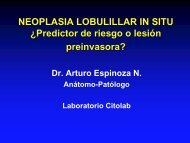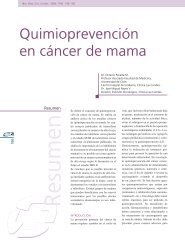Taxanos en la adyuvancia - Sociedad Chilena de MastologÃa
Taxanos en la adyuvancia - Sociedad Chilena de MastologÃa
Taxanos en la adyuvancia - Sociedad Chilena de MastologÃa
You also want an ePaper? Increase the reach of your titles
YUMPU automatically turns print PDFs into web optimized ePapers that Google loves.
IX CONGRESO DE LA SOCIEDAD<br />
CHILENA DE MASTOLOGÍA<br />
“Avances <strong>en</strong> Cáncer <strong>de</strong> Mama”<br />
Viña <strong>de</strong>l Mar, 05-07 Septiembre 2007<br />
“<strong>Taxanos</strong> <strong>en</strong> <strong>la</strong> <strong>adyuvancia</strong>:<br />
maduración <strong>de</strong> nuevos<br />
esquemas y combinaciones <strong>de</strong><br />
Docetaxel y Paclitaxel”<br />
Dr. Héctor Galindo A.<br />
PROGRAMA DE CANCER<br />
PONTIFICIA UNIVERSIDAD CATOLICA DE CHILE
Quimioterapia Adyuvante<br />
¿Por qué?<br />
• Teoría <strong>de</strong> <strong>la</strong> <strong>en</strong>fermedad sistémica:<br />
Micrometástasis a distancia pres<strong>en</strong>tes al<br />
diagnóstico.<br />
• Recurr<strong>en</strong>cias <strong>en</strong> más <strong>de</strong>l 70% <strong>de</strong> mujeres<br />
con cirugía radical <strong>de</strong> mama.<br />
• NSABP B-01 primer estudio clínico <strong>de</strong><br />
quimioterapia adyuvante publicado 1968<br />
(Tiothepa).
Quimioterapia Adyuvante<br />
¿Qué sabemos?<br />
• Mejora <strong>la</strong> sobrevida libre <strong>de</strong> <strong>en</strong>fermedad y<br />
sobrevida global.<br />
• Poliquimioterapia > Monoterapia.<br />
• Múltiples ciclos > Unica exposición.<br />
• Combinación <strong>de</strong> Antraciclinas > CMF.<br />
EBCTCG Lancet 2005
Quimioterapia Adyuvante<br />
¿Qué sabemos?<br />
• B<strong>en</strong>eficio <strong>de</strong> Antraciclinas es con dosis mayor<br />
a 60mg/m2.<br />
CALGB 8541<br />
• Dosis <strong>de</strong> Ciclofosfamida > 600 mg/m2 no<br />
mejoran <strong>la</strong> respuesta.<br />
NSABP B-22<br />
• La quimioterapia parece ser más efectiva <strong>en</strong><br />
tumores RE (-) que <strong>en</strong> RE (+).<br />
EBCTCG
B<strong>en</strong>eficio Absoluto <strong>de</strong> <strong>la</strong> Poliquimioterapia a 15 años:<br />
Grupo Recurr<strong>en</strong>cia Mortalidad<br />
< 50 años 12.3 % 10.0 %<br />
50 – 69 años 4.1 % 3.0 %
¿Cómo mejorar los resultados?<br />
• ¿Esca<strong>la</strong>ndo dosis?<br />
• ¿Integrando nuevos ag<strong>en</strong>tes?<br />
¿Quimioterapia?<br />
¿Ag<strong>en</strong>tes biológicos?<br />
• ¿Mejorando los esquemas <strong>de</strong> administración?<br />
¿Concomitante? ¿Secu<strong>en</strong>cial?<br />
¿Dosis-d<strong>en</strong>sa?
¿Cómo mejorar los resultados?<br />
• ¿Esca<strong>la</strong>ndo dosis?<br />
• ¿Integrando nuevos ag<strong>en</strong>tes?<br />
¿Quimioterapia?<br />
¿Ag<strong>en</strong>tes biológicos?<br />
• ¿Mejorando los esquemas <strong>de</strong> administración?<br />
¿Concomitante? ¿Secu<strong>en</strong>cial?<br />
¿Dosis-d<strong>en</strong>sa?
“Normal” Dose Int<strong>en</strong>sity & Dose Esca<strong>la</strong>tion<br />
10 12<br />
10 10<br />
10 8<br />
10 6<br />
10 4<br />
1<br />
10 2<br />
1<br />
0 2 3 4 5 6 7<br />
Months
Int<strong>en</strong>sidad <strong>de</strong> Dosis “Normal” & Esca<strong>la</strong>ción<br />
<strong>de</strong> Dosis<br />
10 12<br />
10 10<br />
10 8<br />
10 6<br />
10 4<br />
1<br />
10 2<br />
1<br />
0 2 3 4 5 6 7<br />
Meses
¿Cómo mejorar los resultados?<br />
• ¿Esca<strong>la</strong>ndo dosis?<br />
• ¿Integrando nuevos ag<strong>en</strong>tes?<br />
¿Quimioterapia?<br />
¿Ag<strong>en</strong>tes biológicos?<br />
• ¿Mejorando los esquemas <strong>de</strong> administración?<br />
¿Concomitante? ¿Secu<strong>en</strong>cial?<br />
¿Dosis-d<strong>en</strong>sa?
<strong>Taxanos</strong>
¿Por qué <strong>Taxanos</strong>?<br />
• Son activos <strong>en</strong> 1ra. línea <strong>en</strong> Etapa IV: Rango<br />
<strong>de</strong> respuesta 52% a 59%.<br />
• Activos <strong>en</strong> 2da. línea, incluy<strong>en</strong>do <strong>en</strong>fermedad<br />
resist<strong>en</strong>te a Antraciclinas: Rango <strong>de</strong><br />
respuesta 22% a 30%.
<strong>Taxanos</strong><br />
• Provi<strong>en</strong>e <strong>de</strong> <strong>la</strong> corteza <strong>de</strong>l árbol <strong>de</strong><br />
Tejo Europeo: Taxus Baccata.<br />
• Paclitaxel: Arbol <strong>de</strong> Tejo <strong>de</strong>l Pacífico<br />
Taxus Brevifolia.<br />
• Docetaxel: Análogo semisintético <strong>de</strong>l<br />
Taxus Baccata
<strong>Taxanos</strong>:<br />
Mecanismos <strong>de</strong> Acción<br />
• Inhibe <strong>la</strong> formación <strong>de</strong>l huso mitótico.<br />
• Promueve el <strong>en</strong>samble <strong>de</strong> microtúbulos.<br />
• Los estabiliza contra <strong>la</strong> <strong>de</strong>polimerización.<br />
• Inhibe <strong>la</strong> replicación celu<strong>la</strong>r.
DOCETAXEL PRESENTA UN EFECTO INDEPENDIENTE<br />
AL AUMENTAR LA FOSFORILACION DE BCL-2<br />
EFECTO INMUNOMODULADOR (linfocitos T)<br />
EFECTO RADIO SENSIBILIZADOR
Mecanismos <strong>de</strong> Resist<strong>en</strong>cia<br />
• Multiresist<strong>en</strong>cia a drogas (g<strong>en</strong> MDR1- P-<br />
Glicoproteina).<br />
Galleti el al., 2007<br />
• Malfuncionami<strong>en</strong>to<br />
mitótico:<br />
<strong>de</strong>l “checkpoint” <strong>de</strong>l huso<br />
– Expresión disregu<strong>la</strong>da <strong>de</strong> g<strong>en</strong>es <strong>de</strong>l “checkpoint” (MAD1 o MAD2).<br />
– Sobreexpresión <strong>de</strong>l oncogén Aurora-A.<br />
– Inestabilidad cromosómica (Cáncer <strong>de</strong> Colon).<br />
– Sobreexpresión <strong>de</strong> <strong>la</strong> proteína survivin (anti-apoptótica).<br />
Wheatley and Mc Neish, 2005
Mecanismos <strong>de</strong> Resist<strong>en</strong>cia<br />
• Mutación <strong>de</strong> alfa y beta tubulina sitio <strong>de</strong> unión<br />
a taxanos.<br />
Kaval<strong>la</strong>ris et al., 2001<br />
• Sobreexpresión <strong>de</strong> algunas isoformas <strong>de</strong> beta<br />
tubulina que produce una dinámica<br />
microtubu<strong>la</strong>r aum<strong>en</strong>tada.<br />
Goncalves et al., 2001
<strong>Taxanos</strong> <strong>en</strong> <strong>la</strong> Adyuvancia <strong>de</strong><br />
Cáncer <strong>de</strong> Mama
• Nueve estudios fase III.<br />
• Análisis <strong>de</strong> sobrevida (SLE y SG).<br />
• 15.598 paci<strong>en</strong>tes.<br />
• Test <strong>de</strong> heterog<strong>en</strong>eidad no significativos.<br />
Cancer June 1, 2006.
B<strong>en</strong>efit of Taxanes as Adjuvant Chemotherapy for Early<br />
Breast Cancer<br />
Bria et Al., Cancer, 2006.<br />
65 vs 68<br />
70* vs 74*<br />
p < 0.05<br />
73.2 vs 86.7<br />
78.3* vs 90.7*<br />
68 vs 81<br />
75* vs 87*<br />
p < 0.05<br />
p < 0.05
B<strong>en</strong>efit of Taxanes as Adjuvant Chemotherapy for<br />
Early Breast Cancer.<br />
72<br />
P < 0.05<br />
76*<br />
73<br />
P < 0.05<br />
80*<br />
80<br />
P < 0.05<br />
86<br />
Bria et Al., Cancer, 2006.
B<strong>en</strong>efit of Taxanes as Adjuvant<br />
Chemotherapy for Early Breast Cancer.<br />
Bria et Al., Cancer, 2006.
B<strong>en</strong>efit of Taxanes as Adjuvant<br />
Chemotherapy for Early Breast Cancer.<br />
Bria et Al., Cancer, 2006.
Citation Year NTotal<br />
MDACC (5) 2002 524<br />
US Oncology (10) 2003 1016<br />
CALGB 9344 (6) 2003 3121<br />
PACS 01 (11) 2004 1999<br />
NSABP B-28 (7) 2005 3059<br />
HeCOG (8) 2005 595<br />
ECTO (9) 2005 904<br />
ECOG 2197 (13) 2005 2889<br />
BCIRG 001 (12) 2005 1491<br />
Fixed Combined 15598<br />
Random Combined 15598<br />
PValue<br />
.084<br />
.110<br />
.003<br />
.021<br />
.013<br />
.577<br />
.014<br />
.419<br />
.001<br />
.000<br />
.000<br />
B<strong>en</strong>efit of Taxanes<br />
as Adjuvant<br />
Chemotherapy for<br />
Early Breast<br />
Cancer.<br />
Bria et Al., Cancer, 2006.<br />
Citation Year NTotal<br />
PValue<br />
CALGB 9344 (6) 2003 3121<br />
.003<br />
PACS 01 (11) 2004 1999<br />
.021<br />
NSABP B-28 (7) 2005 3059<br />
.013<br />
BCIRG 001 (12) 2005 1491<br />
.001<br />
Fixed Combined 9670<br />
.000<br />
Random Combined 9670<br />
.000
Citation Year NTotal<br />
US Oncology (10) 2003 1016<br />
CALGB 9344 (6) 2003 3121<br />
PACS 01 (11) 2004 1999<br />
NSABP B-28 (7) 2005 3059<br />
HeCOG (8) 2005 595<br />
ECTO (9) 2005 904<br />
ECOG 2197 (13) 2005 2889<br />
BCIRG 001 (12) 2005 1491<br />
Fixed Combined 15598<br />
Random Combined 15598<br />
PValue<br />
.445<br />
.009<br />
.018<br />
.541<br />
.649<br />
.180<br />
.522<br />
.004<br />
.000<br />
.001<br />
B<strong>en</strong>efit of Taxanes<br />
as Adjuvant<br />
Chemotherapy for<br />
Early Breast<br />
Cancer.<br />
Bria et Al., Cancer, 2006.<br />
Citation Year NTotal<br />
PValue<br />
CALGB 9344 (6) 2003 3121<br />
.009<br />
PACS 01 (11) 2004 1999<br />
.018<br />
NSABP B-28 (7) 2005 3059<br />
.541<br />
BCIRG 001 (12) 2005 1491<br />
.004<br />
Fixed Combined 15598<br />
.000<br />
Random Combined 15598<br />
.004
B<strong>en</strong>eficio Absoluto.<br />
• Sobrevida libre <strong>de</strong> <strong>en</strong>fermedad:<br />
– 3.2% a 4.6%.<br />
• Sobrevida global:<br />
– 2.0% a 2.8%.<br />
• Número necesario <strong>de</strong> paci<strong>en</strong>tes a tratar:<br />
– SLE - 23 a 31.<br />
– SG - 36 a 50.
Toxicidad hematológica<br />
Estudio QMT Neutrop<strong>en</strong>ia<br />
Neutrop<strong>en</strong>ia<br />
febril<br />
BCIRG 001<br />
TAC<br />
vs FAC<br />
66% vs 49%<br />
p < 0.05<br />
25% vs 3%<br />
p < 0.05<br />
MDACC<br />
P-FAC<br />
vs FAC<br />
44% vs 24%<br />
p: NR<br />
17% vs 9%<br />
p: NR<br />
GEICAM<br />
FEC-90-P-sem<br />
vs FEC<br />
30% vs 21%<br />
p < 0.05<br />
9% vs 5%<br />
p = 0.004<br />
PACS 01<br />
FEC100-T<br />
vs FEC100<br />
NR<br />
4.6% vs 1%<br />
p = 0.001
A meta-analysis of taxanes in adjuvant<br />
chemotherapy (ACT) of early breast Cancer (EBC)<br />
Norwak et al, Proccedings ASCO, 2007: N° 545.<br />
• 20 Estudios id<strong>en</strong>tificados:<br />
11 a<strong>de</strong>cuados (4 abstracts; 7 publicaciones).<br />
• Mediana <strong>de</strong> seguimi<strong>en</strong>to: 54.6 meses.<br />
• 17.056 mujeres para análisis <strong>de</strong> SG:<br />
HR 0.81 (0.75-0.88, p
¿Cómo mejorar los resultados?<br />
• ¿Esca<strong>la</strong>ndo dosis?<br />
• ¿Integrando nuevos ag<strong>en</strong>tes?<br />
¿Quimioterapia?<br />
¿Ag<strong>en</strong>tes biológicos?<br />
• ¿Mejorando los esquemas <strong>de</strong><br />
administración?<br />
¿Concomitante? ¿Secu<strong>en</strong>cial?<br />
¿Dosis-d<strong>en</strong>sa?
Terapia secu<strong>en</strong>cial<br />
10 12<br />
10 10<br />
10 8<br />
10 6<br />
10 4<br />
1<br />
10 2<br />
1<br />
0 2 3 4 5 6 7<br />
Meses
Int<strong>en</strong>sidad <strong>de</strong> dosis “Normal” & Aum<strong>en</strong>to<br />
<strong>de</strong> <strong>la</strong> D<strong>en</strong>sidad <strong>de</strong> Dosis<br />
10 12<br />
10 10<br />
10 8<br />
10 6<br />
10 4<br />
1<br />
10 2<br />
1<br />
0 2 3 4 5 6 7<br />
Meses
¿Cuál es el mejor esquema<br />
<strong>de</strong> terapia?
Cancer Treatm<strong>en</strong>t Reviews. 2007.
Terapia Concomitante<br />
Antraciclinas Vs Antraciclinas + <strong>Taxanos</strong><br />
• Alta incid<strong>en</strong>cia <strong>de</strong> Neutrop<strong>en</strong>ia febril.<br />
• Requiere profi<strong>la</strong>xis primaria con G-CSF.
Terapia secu<strong>en</strong>cial<br />
Antraciclinas Vs Antraciclinas + <strong>Taxanos</strong><br />
• M<strong>en</strong>or toxicidad hematológica, gastrointestinal y ev<strong>en</strong>tos<br />
cardiacos.<br />
• Mayor incid<strong>en</strong>cia <strong>de</strong> e<strong>de</strong>ma y estomatitis grado 3/4.<br />
• Mayor mialgia y neuropatía periférica con Paclitaxel.
Terapia Concomitante<br />
Antraciclinas Vs <strong>Taxanos</strong><br />
• Alta incid<strong>en</strong>cia <strong>de</strong> neutrop<strong>en</strong>ia febril <strong>en</strong> el<br />
grupo <strong>de</strong> taxanos.
Docetaxel vs paclitaxel<br />
trisemanal vs semanal<br />
• No se <strong>en</strong>contró difer<strong>en</strong>cias significativas.<br />
• Mejor SLE con paclitaxel semanal o docetaxel c/3 semanas.<br />
Sparano et al. ASCO 2007.<br />
• Docetaxel 100 mg C/3 semanas:<br />
Mayor neutrop<strong>en</strong>ia y neutrop<strong>en</strong>ia febril.
Dosis d<strong>en</strong>sas vs conv<strong>en</strong>cional<br />
secu<strong>en</strong>cial vs concurr<strong>en</strong>te<br />
• Administración secu<strong>en</strong>cial vs concurr<strong>en</strong>te sin difer<strong>en</strong>cias<br />
significativas.<br />
• No se observó interacción <strong>en</strong>tre d<strong>en</strong>sidad <strong>de</strong> dosis y<br />
secu<strong>en</strong>cia <strong>de</strong> administración.<br />
• Mayor b<strong>en</strong>eficio los tumores RE (-).<br />
• Importancia uso <strong>de</strong> G-CSF.
¿Costos?
Régim<strong>en</strong><br />
Costo x 6<br />
ciclos<br />
TAC<br />
FEC x 3<br />
Doc x 3<br />
AC<br />
$8.239.812 $5.405.751 $995.532
Resum<strong>en</strong><br />
• Los <strong>Taxanos</strong> han <strong>de</strong>mostrado b<strong>en</strong>eficio <strong>en</strong> <strong>la</strong> terapia<br />
adyuvante <strong>de</strong> cáncer <strong>de</strong> mama.<br />
• Deb<strong>en</strong> utilizarse <strong>en</strong> paci<strong>en</strong>tes <strong>de</strong> alto riesgo con<br />
linfonodos positivos<br />
• Debe evaluarse el b<strong>en</strong>eficio <strong>en</strong> paci<strong>en</strong>tes con linfonodos<br />
negativos <strong>de</strong> alto riesgo.<br />
• Son regim<strong>en</strong>es <strong>de</strong> alta toxicidad y requier<strong>en</strong> apoyo con<br />
G-CSF.<br />
• La elección <strong>de</strong>l esquema se <strong>de</strong>be basar <strong>en</strong> el perfil <strong>de</strong><br />
toxicidad y <strong>la</strong> conv<strong>en</strong>i<strong>en</strong>cia <strong>de</strong>l paci<strong>en</strong>te.<br />
• Tres regim<strong>en</strong>es han <strong>de</strong>mostrado superioridad <strong>en</strong> SLE y/o<br />
SG:<br />
TAC x 6<br />
FEC x 3 – Taxotere x 3<br />
FEC x 4 – Paclitaxel x 8 semanal.<br />
• Son regim<strong>en</strong>es <strong>de</strong> alto costo económico.
GRACIAS



